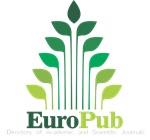Preparation and Characterization of Giant Tiger Shrimp (Penaeus monodon) Shell-Based Chitin as Biocoagulant For Water Purification
Abstract
Abstract: Giant tiger shrimp (Penaeus monodon) shells are solid waste that can be utilized for water purification by converting them into chitin-based biocoagulant. The extraction and deproteination of giant tiger shrimp shells (Penaeus monodon) resulted in 83.34% w/w, followed by a demineralization yield of 91.61% w/w product. Chitin extract was used as a biocoagulant using the Jar test method on a fixed variable of 1 L well water and the independent variables of chitin weight (mg) and stirring speed (rpm). The results showed that 15 mg/L chitin reduced the turbidity value of well water from 3.08-1.03 NTU and decreased the Total Dissolved Solids (TDS) from 555-500 mg/L, at 200 rpm and pH 8.4. In conclusion, our investigation proves that chitin derived from giant tiger shrimp shells can be used as a biocoagulant for water purification.
Abstrak: Kulit udang merupakan limbah padat yang dapat digunakan untuk penjerniahan air, dengan mengonversi limbah tersebut menjadi biokoagulan berbasis chitin. Limbah kulit udang Windu (Penaeus monodon) diekstrak menjadi chitin sebagai bahan baku Biokoagulan dalam penjernihan air sumur. Proses ekstraksi kulit udang windu (Penaeus monodon) diperoleh rendemen sebesar 83,34% melalui proses deproteinasi, diperoleh rendemen sebanyak 91,61% melalui proses demineralisasi. Hasil ekstrak chitin digunakankan sebagai biokoagulan dengan metode Jar test pada variabel tetap sebesar 1 L air sumur dan variabel berubah adalah massa chitin dan waktu pengadukan. Hasil penelitian menunjukkan bahwa 15 mgram/L chitin mampu menurunkan nilai kekeruhan air sumur dari 3,08-1,03 (NTU) dan menurunkan Total Dissolved Solids TDS dari 555-500 (mgram/L), dengan kecepatan rotasi 200 rpm untuk nilai pH 8,4. Kesimpulan, penelitian ini menunjukkan bahwa chitin yang diperoleh dari kulit udang windu dapat digunakan sebagai biokoagulan pada proses penjernihan air.
Keywords
Full Text:
PDFReferences
Al-Jazairi, A. B. J. (2018). Tafsir Al-Qur’an Al-Aisar. Darus Sunnah.
Dao, V.H., Cameron, N.R., & Saito, K. (2016). Synthesis, properties, and performance of organic polymers employed in flocculation applications. Polym. Chem., 7, 11–25.
Dompeipen, E, J. (2017). Isolasi dan Identifikasi Kitin dan Kitosan dari Kulit Udang Windu (Penaeus monodon) dengan Spektroskopi Inframerah. Majalah BIAM., 31-41.
Ezemagu, I. G., Ejimofor, M. I., & Menkiti, M. C. (2020). Turbidimetric study for the decontamination of paint effluent (PE) using mucuna seed coagulant (MSC): Statistical design and coag-flocculation modelling. In Environmental Advances (Vol. 2, p. 100023). https://doi.org/10.1016/j.envadv.2020.100023
Frantz, T. S., Farias, B. S. de, Leite, V. R. M., Kessler, F., Cadaval, T. R. S. A., & Pinto, L. A. de A. (2020). Preparation of new biocoagulants by shrimp waste and its application in coagulation-flocculation processes. Journal of Cleaner Production, 269. https://doi.org/10.1016/j.jclepro.2020.122397
Hambali, M., Wijaya, E., & Reski, A. (2017). Pembuatan Kitosan Dan Pemanfaatannya Sebagai Agen Koagulasi-Flokulasi. Jurnal Teknik Kimia., 23(2), 104–113.
Hendrawati, & Susi, S. N. (2016). Penggunaan Kitosan sebagai Koagulan Alami dalam Perbaikan Kualitas Air Danau. Valensi, 1(1), 1–11.
Islem, Y., & Marguerite, R. (2015). Chitin and chitosan preparation from marine sources. Structure, properties and applications. Mar. Drugs, 13, 1133–1174.
Kementerian Riset. (2019). Klasifikasi udang windu.
Pandharipande, S L, & P. H. B. (2016). “Synthesis of Chitin from Crab Shells and Its Utilization in Preparation of Nanostructured Film.”: Vol. 5(5):
Patricia, M. F., Purwono, & Budihardjo, M. A. (2018). Dose of Biocoagulant-Mixing Rate Combinations for Optimum Reduction of COD in Wastewater. E3S Web of Conferences, 31, 8–11. https://doi.org/10.1051/e3sconf/20183103018
Pratama, A, et al. (2016). Penggunaan cangkang udang sebagai biokoagulan untuk menurunkan kadar TSS, kekeruhan dan fosfat pada air limbah usaha laundry. Undip t. Lingkungan, 5(2), 3.
Sa’diyah, H. (2018). Dalam Pandangan Hukum Islam. At-Turāṡ, V(1), 46–58.
Saxena, K., Brighu, U., & Choudhary, A. (2019). Coagulation of humic acid and kaolin at alkaline pH: Complex mechanisms and effect of fluctuating organics and turbidity. In Journal of Water Process Engineering (Vol. 31). https://doi.org/10.1016/j.jwpe.2019.100875
Teh, C.Y., Budiman, P.M., Shak, K.P.Y., and W. T. Y. (2016). Recent advancement of coagulation-flocculation and its application in wastewater treatment. Ind. Eng. Chem. Res., 55, 4363–4389.
Wibowo, P., Bayu, R., Wijoyo, T., & Rezeki, S. (2019). Pengaruh Konsentrasi NaOH pada Deasetilasi Kitin dari Cangkang Udang Putih ( Litopenaeus vannamei ) dan Aktivitasnya pada Air Gambut. 07(1), 37–43.
Yang, R., Li, H., Huang, M., Yang, H., Li, A. (2016). A review on chitosan-based flocculants and their applications in water treatment. Water Res., 95, 59–89.
Yang, J., Yu, Z., Yi, P., Frape, S. K., Gong, M., & Zhang, Y. (2020). Evaluation of surface water and groundwater interactions in the upstream of Kui river and Yunlong lake, Xuzhou, China. In Journal of Hydrology (Vol. 583). https://doi.org/10.1016/j.jhydrol.2020.124549
Ziming, L., Lifeng, C., Zhenxiong, Y., Xiyong, C., & Xinpeng, W. Y. W. (2021). Film-like chitin_polyethylenimine biosorbent for highly efficient removal of uranyl-carbonate compounds from water - main.pdf. Journal of Environmental Chemical Engineering.
DOI: http://dx.doi.org/10.22373/ekw.v7i2.8229
Refbacks
- There are currently no refbacks.
Copyright (c) 2021 Khairun Nisah, Rizna Rahmi

This work is licensed under a Creative Commons Attribution-ShareAlike 4.0 International License.
P-ISSN : 2460-8912
E-ISSN : 2460-8920
ELKAWNIE
This work is licensed under a Creative Commons Attribution-ShareAlike 4.0 International License.
Elkawnie: Journal of Islamic Science and Technology in 2022. Published by Faculty of Science and Technology in cooperation with Center for Research and Community Service (LP2M), UIN Ar-Raniry Banda Aceh, Aceh, Indonesia.
View full page view stats report click here

























